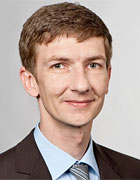
Prof. Dr.-Ing. Michael W. Gee
Academic Career and Research Areas
Professor Gee’s area of expertise focuses on the development of efficient methods for numerical simulation of complex mechanical and physical phenomena. In this context, his primary focus is on efficient methods for computational structural and fluid mechanics, frictional contact, algebraic multigrid, multiphysics coupled problems and, more recently, on inverse, control and uncertain problems. As regards applications of his research, he focuses on interdisciplinary projects in biomechanics and mechanobiology, medical device development and aerospace applications.
Professor Gee studied civil engineering at the University of Stuttgart from where he also received his doctoral degree in computational mechanics. Afterwards, he worked for two years as a scientific employee in the Computational Mathematics and Parallel Algorithms Department at Sandia National Laboratories in Albuquerque, USA. In 2006 he joined TUM where he headed several research groups on biomechanics, frictional contact, parallel algebraic multilevel methods and domain decomposition, as well as software design and high performance computing. In 2011 he was appointed associate professor for Mechanics and High Performance Computing in the Department of Mechanical Engineering. He teaches Engineering Mechanics in the TUM Munich School of Engineering as well as Advanced Parallel Computing in Mechanical Engineering.
Key Publications (all publications)
Bruder, L., Pelisek, J., Eckstein, H-H., Gee, M. W.: Biomechanical rupture risk assessment of abdominal aortic aneurysms using clinical data: A patient-specific, probabilistic framework and comparative case-control study. PLoS ONE 15 (11), 2020.
AbstractHemmler, A., Lutz, B., Kalender, G., Reeps, C., Gee, M.W.: Patient-specific in silico endovascular repair of abdominal aortic aneurysms: application and validation. Biomechanics and Modeling in Mechanobiology 18 (4), 2019, 983-1004.
AbstractHirschvogel, M., Jagschies, L., Maier, A., Wildhirt, S.M., Gee, M.W.: An in‐silico twin for epicardial augmentation of the failing heart. International Journal for Numerical Methods in Biomedical Engineering 35 (10), 2019.
AbstractThon, M.P., Ford, H.Z., Gee, M.W., Myerscough, M.R.: A Quantitative Model of Early Atherosclerotic Plaques Parameterized Using In Vitro Experiments. Bulletin of Mathematical Biology, 2018.
AbstractMayr, M.; Klöppel, T.; Wall, W. A.; Gee, M. W.: A Temporal Consistent Monolithic Approach to Fluid-Structure Interaction Enabling Single Field Predictors. SIAM Journal on Scientific Computing 37 (1), 2015, B30-B59.
AbstractIf you wish your profile to be changed or updated please contact Franz Langer.